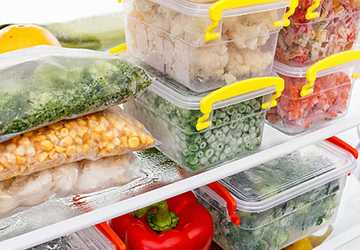Clean Eating Simplified A Guide to Nourishing Your Body
Healthy eating is about choosing whole, natural foods and minimizing processed products. This way, you provide your body with essential nutrients while avoiding unnecessary additives and preservatives. Focusing on fresh fruits, vegetables, lean proteins, whole grains, and healthy fats can support overall health and well-being.

This guide will help you understand how to eat healthy and provide practical tips to make eating more accessible and enjoyable. Whether you are just starting or want to improve your approach, these insights will help you make better daily food choices.
What does it mean to eat healthy?
Healthy eating means focusing on foods that are as natural as possible; these include fruits, vegetables, whole grains, lean proteins, and healthy fats. It also means avoiding processed foods, refined sugars, and artificial ingredients. The goal is to nourish your body with quality foods that provide essential nutrients.
Benefits of Healthy Eating
There are several benefits of eating healthy:
Improved digestion: Whole foods are easier to digest and help keep your gut healthy.
More energy: Whole foods provide sustained energy, while processed foods can cause energy spikes and crashes.
More beautiful skin: Clean eating can improve the appearance of your skin by providing you with essential vitamins and minerals.
Weight Management: Clean eating can help you maintain a healthy weight by reducing your caloric intake from processed foods.
Improve Mental Clarity: Nutrient-dense foods support brain health and improve focus and concentration.
Reduce Inflammation: Eating clean can reduce inflammation and your risk of chronic disease.
Essential Parts of Clean Eating
Fruits and Vegetables: Fruits and vegetables are the cornerstones of clean eating. They are rich in vitamins, minerals, and antioxidants. Mix half of your plate with various colourful fruits and vegetables at each meal to ensure you get a wide range of nutrients.
Whole Grains: Whole grains like brown rice, quinoa, oats, and whole wheat are excellent sources of fibre, vitamins, and minerals. They can help you stay fuller longer and stabilize blood sugar levels. Avoid refined grains like white rice and white bread, which have been stripped of nutrients.
Lean Protein: Lean protein is essential for muscle repair and growth. Choose sources like chicken, turkey, fish, beans, and more. These choices have less saturated fat than red and processed meats, making them healthier.
Healthy Fats: Healthy fats are essential for brain health and hormone production. Include sources like avocados, nuts, seeds, and olive oil. Avoid trans fats and limit saturated fats, which can negatively impact heart health.
Healthy Eating Tips
Read labels: When buying packaged foods, avoid added sugars, artificial ingredients, and unhealthy fats.
Cook at Home: Cooking at home allows you to control ingredients and avoid hidden additives.
Stay Hydrated: Drink plenty of water throughout the day. Avoid sugary drinks and excess caffeine.
Plan your meals: Planning can help you make healthier choices and reduce the temptation to eat processed foods.
Practice Moderation: You don't have to be perfect. It's okay to indulge occasionally as long as you maintain healthy eating habits most of the time.
Shop Smart: Create a shopping list based on healthy eating principles to avoid impulse buying processed foods.
Healthy Eating on a Budget
Healthy eating doesn't have to be expensive. Here are some tips that can help you eat healthy without spending too much:
Buy in bulk: Bulk purchases of grains, beans, and nuts are often more cost-effective.
Seasonal Produce: Buy seasonal fruits and vegetables. They're often cheaper and fresher.
Frozen foods: Frozen fruits and vegetables are just as nutritious as fresh ones and often cost less.

Plan your meals: Planning can help you buy only what you need, thus avoiding food waste.
Cook in bulk: Cooking large meals and freezing portions can save time and money.
Grow your vegetables: If possible, grow your herbs and vegetables; this is cost-effective and ensures you have fresh produce.
Example of a Clean Eating Plan
Here is a simple meal plan to help you get started with clean eating:
Breakfast: Start the day with porridge topped with fresh berries, nuts and honey. You can also try a green smoothie made with spinach, banana, almond milk and chia seeds for a nutritional boost.
Lunch: For lunch, enjoy a quinoa salad with mixed greens, cherry tomatoes, cucumbers and grilled chicken. Another option is a vegetable stir-fry with brown rice and tofu for a healthy and filling meal.
Dinner options include grilled salmon, baked sweet potatoes and steamed broccoli. Lentil soup with whole-wheat bread is another hearty option.
Snacks: For a snack, choose fresh fruit like apples, oranges, or berries. Nuts and seeds like almonds, walnuts, or sunflower seeds are also good choices. Raw vegetables like carrot sticks, cucumber slices, or pepper strips make a crunchy, healthy snack with hummus.
Overcoming Common Challenges
Processed Food Cravings
It's normal to crave processed foods, especially if you're used to eating them regularly. How to deal with cravings:
Find healthy alternatives: Replace unhealthy snacks with more nutritious options. For example, choose popcorn from the hot air machine instead of chips.
Stay hydrated: Sometimes, thirst can be confused with hunger. Drink water before snacking.
Have healthy snacks ready: Healthy options can help you resist temptation.
Eat out
Eating healthy can be challenging when dining out, but it's possible with a few strategies:
Choose smart: Choose dishes made with whole foods. Salads, grilled meats and vegetable side dishes are all excellent choices.
Ask for changes: Don't be afraid to ask for changes, like adding dressing on the side or substituting salad for fries.
Watch portion sizes: Restaurant portions can be significant. Consider sharing a meal or saving half for later.
Avoid sauces and dressings: They can contain hidden sugars and unhealthy fats. Order them separately or skip them altogether.
Stay motivated
Staying motivated is essential to maintaining a clean eating lifestyle. Here are some tips to help you stay on track:
Set realistic goals: Start with small, achievable goals. Gradually incorporate more clean foods into your diet.
Track your progress: Keep a food journal to record your eating and feelings. This can help you identify patterns and stay motivated.
Find support: Join a clean eating group or find a partner to share your journey with. Support can make it easier to stick to your goals.
Celebrate small successes: Recognize your progress and reward yourself with good things that align with your goals.
Conclusion
Clean eating is an effective way to nourish your body and improve your health. By focusing on whole foods and minimizing processed products, you can enjoy the benefits of better digestion, more energy, and improved health. Start with small changes and gradually incorporate more clean foods into your diet. Remember, the goal is progress, not perfection.
With these tips and strategies, you can make clean eating a sustainable and enjoyable part of your lifestyle. Embrace the journey, take it one step at a time, and make choices that support your health and well-being.





